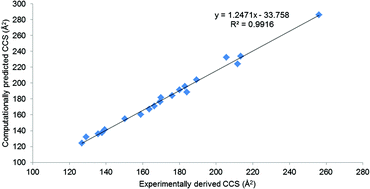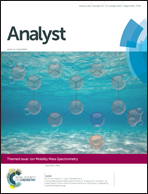How useful is molecular modelling in combination with ion mobility mass spectrometry for ‘small molecule’ ion mobility collision cross-sections?†
Abstract
Ion mobility mass spectrometry is used to measure the drift-time of an ion. The drift-time of an ion can be used to calculate the collision cross-section (CCS) in travelling wave ion mobility (e.g. Waters Synapt and Vion instruments) or directly determine the experimental CCS (e.g. Agilent 6560 instrument and many drift-tube instruments). A comparison of the experimental CCS and theoretical CCS values obtained from trajectory method He(g) parameterised MOBCAL and N2(g) parameterised MOBCAL software, for a range of 20 ‘small molecules’ is presented. This study utilises density functional theory B3LYP methods and the 6-31G+(d,p) basis set to calculate theoretical CCS values. This study seeks to assess the accuracy of a common procedure using CCS calibration with poly-(D/L)-alanine derived from drift-cell measurements and the original release of MOBCAL software and compare it with recent improvements with a drug-like molecule calibration set and a revision of MOBCAL parameterised for N2(g) drift gas. This study represents one of the first quantitative evaluations of the agreement between theoretical CCS and experimental CCS values for a range of small pharmaceutically relevant molecules using travelling wave ion mobility mass spectrometry. Accurate theoretical CCS may allow optimisation of ion mobility separations in silico, provide CCS databases that can confirm structures without the need for alternative analytical tools such as nuclear magnetic resonance spectroscopy (NMR) and assignment of unknowns and positional isomers without requiring reference materials.

- This article is part of the themed collection: Ion Mobility Mass Spectrometry

 Please wait while we load your content...
Please wait while we load your content...